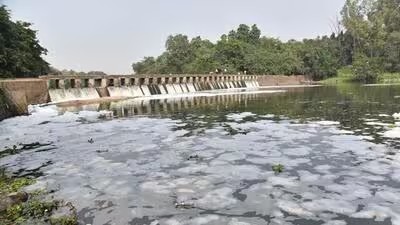
Pavana River

06.11.2023
Pavana River , Daily Current Affairs , RACE IAS : Best IAS Coaching in Lucknow
|
For Prelims:About Pavana River,Pavana Nagar Dam For mains paper 3 :Western Ghats,Madhav Gadgil Report, 2011,Kasturirangan Committee Report, 2012 |
WHY IN NEWS?
Citizens and environmental activists have expressed concern over the thick layer of (toxic) foam seen on the Pavana River near Kejudevi Temple in Thergaon, Maharashtra.
About Pavana River
- It is located in the Pune District in the state of Maharashtra.
- The river is a prominent river that runs through Pune City and separates it from the Pimpri-Chinchwad district.
- It comes from the Western Ghats, around 6 kilometers south of Lonavala.
- It is a tributary of the Bhima River that joins the Mula River in Pune.
- Flowing eastward at first, it turns south and travels through the suburbs of Dehu, Chinchwad, Pimpri, and Dapodi before joining the Mula River.
- The "Pavana Nagar Dam" is being built on this river at Pavana Nagar.
Pavana Nagar Dam
- It is a gravity earthfill.
- It has a total storage capacity of 30,500.00 km3 and measures 1,329 m (4,360 ft) long and 42.37 m (139.0 ft) high.
- It was created to give enough water to the surrounding communities. It is the region's primary supply of water.
The Western Ghats
- The subduction of the Arabian basin and the tilting of the peninsula in the east and northeast during the Himalayan uplift generated the Western Ghats.
- As a result, it seems to block mountains in the west, with escarpments and staircase formations on the slope.
- The Western Ghats is one of the world's eight biodiversity hotspots, spanning six states: Gujarat, Maharashtra, Goa, Karnataka, Tamil Nadu, and Kerala.
- It is designated as a UNESCO World Heritage Site. It is one of the world's eight "hottest hotspots" of biological variety.
- The Western Ghats, according to UNESCO, is older than the Himalayas. They have an impact on Indian monsoon weather patterns by intercepting rain-laden monsoon winds that blow in from the southwest in late summer.
- It spans all the way from Tapi Valley to Kanyakumari. It is known as Sahyadri till 11° N.
- It is divided into three pieces.
- Northern Western Ghats
- Middle Sahyadri(Central Western Ghats)
- Southern Western Ghats
Madhav Gadgil Report, 2011
- It defined the boundaries of the Western Ghats for the purposes of ecological management.
- It proposed that this entire area be designated as ecologically sensitive area (ESA).
- Within this area, smaller regions were to be identified as ESZ I, II or III based on their existing condition and nature of threat.
- Hence 64% of the area would fall under ESZ I or II or under already existing protected areas such as wildlife sanctuaries or national parks. 3 indicators for ESZ1 are elevation, slope and natural vegetation. Nothing was permitted in ESZ I.
- The committee proposed a Western Ghats Ecology Authority to regulate these activities in the area.
- But none of the 6 States accepted the recommendations.
Kasturirangan Committee Report, 2012
- It was set up to examine the Gadgil Committee report in a holistic and multidisciplinary fashion in the light of responses received.
- It brought just 37% of Western Ghats under ESA (unlike 64% suggested by Gadgil).
- The villages falling under ESA will be involved in decision making on the future projects.
- All projects will require prior informed consent and no objection from Gram Sabha.
- A ban on mining, quarrying and sand mining and new polluting industries. No new thermal power projects, but hydro power projects allowed with restrictions.
- Forest diversion could be allowed with extra safeguards.
- Building and construction projects up to 20,000 sq m were to be allowed but townships were to be banned.
Source: Hindustan times